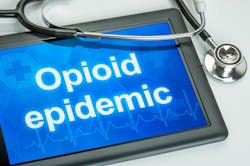In April, a Michigan statewide assessment was conducted to identify trends that will assist government agencies, lawmakers and local community leaders to tailor laws, target resources, and design innovative programs to best address the opioid epidemic in Michigan.
The assessment was completed by the Dept. of Licensing and Regulatory Affairs (LARA) and Appriss Health—a Louisville, Ky.-based technology company—as part of Michigan’s strategy to prevent opioid abuse. According to state officials, LARA is one of the first state government agencies in the country to conduct this comprehensive assessment to better inform its statewide battle with the opioid epidemic.
The report specifically overlays three years (2013 to 2015) of well-documented cases of unintentional overdose death with five years (2012 to 2017) of prescription records in the Michigan Automated Prescription System (MAPS). In total, more than 7.5 million patients receiving 103.2 million prescriptions over the last five years were linked to 5,261 overdose deaths, the data revealed. The assessment also found that 1 out of every 100 patients who died of drug-related overdoses visited at least 21 prescribers.
“Michigan is at the forefront of using data and technology to identify prevent and manage substance use disorders across the state,” Lt. Governor Brian Calley said in an April statement. “This assessment provides a holistic image of the opioid epidemic in Michigan and will provide immense assistance as we develop and implement prevention and treatment strategies to assist individuals suffering from substance use disorder.”
Kim Gaedeke, LARA’s deputy director, explains that by looking at the overdose death data from a certain period of time, and overlaying that with prescription drug monitoring program (PDMP) data within MAPS, state health officials could then find out if there was any relationship between the two, specifically looking to see if patients were receiving a prescription drug prior to the overdose. “A lot of the time you will hear that a prescription drug led to an overdose death, and then the individual turns to, and gets addicted to, illicit [street] drugs. So we wanted to look at both data sets together and see if there was a relationship,” Gaedeke says.
The assessment utilized Appriss Health’s artificial intelligence (AI) and machine learning technologies, including its “overdose risk score” that predicts the likelihood of a drug-related death, with the goal to reveal critical insights into the opioid epidemic to enable more advanced interventions and responses. The same technologies are utilized in NarxCare, a substance use disorder platform deployed to prescribers and pharmacists across Michigan to assess risk and improve patient care to help address the opioid epidemic, LARA officials noted.
As such, Gaedeke says that a core realization from the assessment was the value that could be gained from combining the overdose data—both fatal and non-fatal—with the PDMP data, “because you can then get into better predictive modeling and hopefully prevent an overdose.” Even more, she adds, “If you can identify substance abuse disorder, and establish protocols, the clinicians can then intervene at the appropriate time prior to an overdose occurring.” That’s the next step, Gaedeke says—getting the overdose data in real-time and including it with PDMP data for better predictive modeling.
Gaedeke offers an example of a patient who is coming into a clinic, and the clinician can not only see the prescription drug history—including types of narcotics or opioids—but can also can see in real time that the patient had a non-fatal overdose episode a month ago, for instance.
“The practitioner, in this case, would hopefully [realize] that something is going on with the patient. Maybe the patient has become hooked on the drugs that he or she was receiving, or maybe he or she is going from clinic to clinic to get additional drugs. If you know this person has a non-fatal overdose episode, that risk score of a potential overdose again that can ultimately lead to death becomes much stronger,” Gaedeke asserts. Indeed, having those other data sets included with the PDMP data strengthens the risk score and allows for preventative measures to be provided.
Although Gaedeke acknowledges that it’s too early in the process to get data on overdose preventions, things have certainly changed compared to how advanced the state was a year ago, prior to using the Appriss Health platform. “We were struggling to get our users to use MAPS in a meaningful and valuable way. But since launching and investing the dollars into [this system], we now can have Appriss Health migrate 120 million records and have them maintain things,” she says.
Moving forward, Gaedeke believes that once LARA gets real-time data, the next level will be identifying where overdose incidences are occurring geographically. Then, the goal will be to examine if clinicians having this real-time data is actually leading them to making better decisions, which could potentially also be tied to a drop in controlled substances that are prescribed.
Of course, the elephant in the room is still illicit drugs, Gaedeke admits. “As we adjust the prescription drug side, the question becomes, how can we address the street drugs issue that all states are facing?” But it’s early along in the process, she notes. “This statewide assessment has allowed us to start having those conversations, and we are [seeing] the value of having the overdose data in real time to better prevent and predict before an overdose occurs. Once we can get through some of these challenges, I think you’ll see better outcomes, which is what we are all striving for.”


